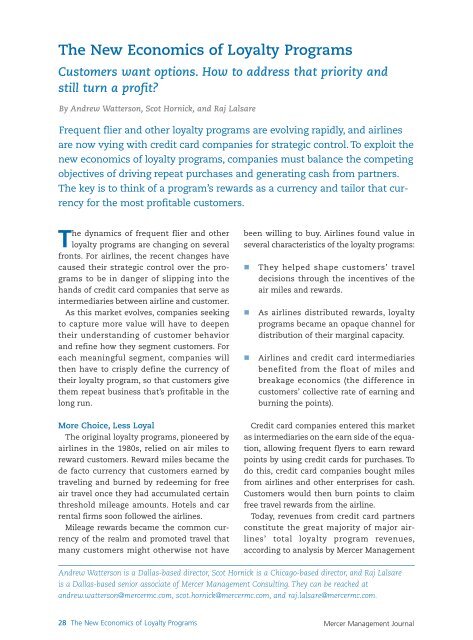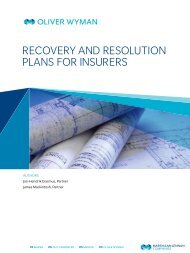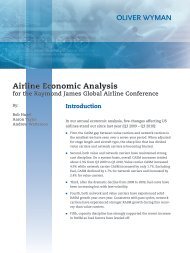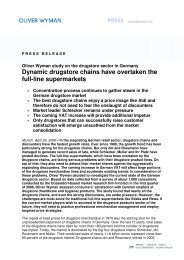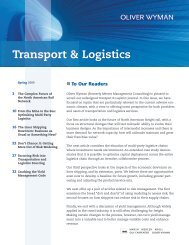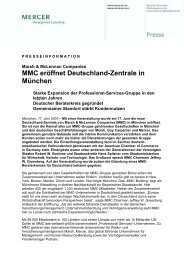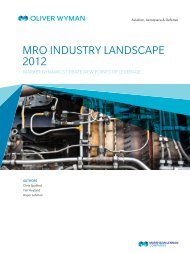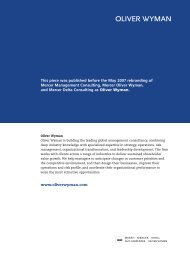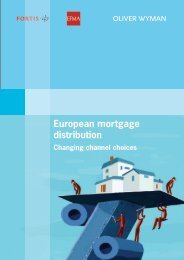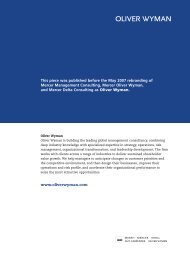The New Economics of Loyalty Programs Customers ... - Oliver Wyman
The New Economics of Loyalty Programs Customers ... - Oliver Wyman
The New Economics of Loyalty Programs Customers ... - Oliver Wyman
You also want an ePaper? Increase the reach of your titles
YUMPU automatically turns print PDFs into web optimized ePapers that Google loves.
<strong>The</strong> <strong>New</strong> <strong>Economics</strong> <strong>of</strong> <strong>Loyalty</strong> <strong>Programs</strong><br />
<strong>Customers</strong> want options. How to address that priority and<br />
still turn a pr<strong>of</strong>it?<br />
By Andrew Watterson, Scot Hornick, and Raj Lalsare<br />
Frequent flier and other loyalty programs are evolving rapidly, and airlines<br />
are now vying with credit card companies for strategic control. To exploit the<br />
new economics <strong>of</strong> loyalty programs, companies must balance the competing<br />
objectives <strong>of</strong> driving repeat purchases and generating cash from partners.<br />
<strong>The</strong> key is to think <strong>of</strong> a program’s rewards as a currency and tailor that currency<br />
for the most pr<strong>of</strong>itable customers.<br />
<strong>The</strong> dynamics <strong>of</strong> frequent flier and other<br />
loyalty programs are changing on several<br />
fronts. For airlines, the recent changes have<br />
caused their strategic control over the programs<br />
to be in danger <strong>of</strong> slipping into the<br />
hands <strong>of</strong> credit card companies that serve as<br />
intermediaries between airline and customer.<br />
As this market evolves, companies seeking<br />
to capture more value will have to deepen<br />
their understanding <strong>of</strong> customer behavior<br />
and refine how they segment customers. For<br />
each meaningful segment, companies will<br />
then have to crisply define the currency <strong>of</strong><br />
their loyalty program, so that customers give<br />
them repeat business that’s pr<strong>of</strong>itable in the<br />
long run.<br />
More Choice, Less Loyal<br />
<strong>The</strong> original loyalty programs, pioneered by<br />
airlines in the 1980s, relied on air miles to<br />
reward customers. Reward miles became the<br />
de facto currency that customers earned by<br />
traveling and burned by redeeming for free<br />
air travel once they had accumulated certain<br />
threshold mileage amounts. Hotels and car<br />
rental firms soon followed the airlines.<br />
Mileage rewards became the common currency<br />
<strong>of</strong> the realm and promoted travel that<br />
many customers might otherwise not have<br />
28 <strong>The</strong> <strong>New</strong> <strong>Economics</strong> <strong>of</strong> <strong>Loyalty</strong> <strong>Programs</strong><br />
been willing to buy. Airlines found value in<br />
several characteristics <strong>of</strong> the loyalty programs:<br />
� <strong>The</strong>y helped shape customers’ travel<br />
decisions through the incentives <strong>of</strong> the<br />
air miles and rewards.<br />
� As airlines distributed rewards, loyalty<br />
programs became an opaque channel for<br />
distribution <strong>of</strong> their marginal capacity.<br />
� Airlines and credit card intermediaries<br />
benefited from the float <strong>of</strong> miles and<br />
breakage economics (the difference in<br />
customers’ collective rate <strong>of</strong> earning and<br />
burning the points).<br />
Credit card companies entered this market<br />
as intermediaries on the earn side <strong>of</strong> the equation,<br />
allowing frequent flyers to earn reward<br />
points by using credit cards for purchases. To<br />
do this, credit card companies bought miles<br />
from airlines and other enterprises for cash.<br />
<strong>Customers</strong> would then burn points to claim<br />
free travel rewards from the airline.<br />
Today, revenues from credit card partners<br />
constitute the great majority <strong>of</strong> major airlines’<br />
total loyalty program revenues,<br />
according to analysis by Mercer Management<br />
Andrew Watterson is a Dallas-based director, Scot Hornick is a Chicago-based director, and Raj Lalsare<br />
is a Dallas-based senior associate <strong>of</strong> Mercer Management Consulting. <strong>The</strong>y can be reached at<br />
andrew.watterson@mercermc.com, scot.hornick@mercermc.com, and raj.lalsare@mercermc.com.<br />
Mercer Management Journal
Exhibit 1 <strong>The</strong> loyalty space has changed<br />
Airline frequent<br />
flyer programs<br />
Perceived value<br />
<strong>of</strong> loyalty<br />
programs to<br />
customers<br />
Competing<br />
programs<br />
1990 Today<br />
Consulting. <strong>The</strong> top three North American<br />
airlines—American, Delta, and United—each<br />
derive close to $1 billion in revenues from<br />
their loyalty programs, from more than 50<br />
million members each.<br />
<strong>The</strong> programs encourage customers to earn<br />
and burn mileage points in order to sustain a<br />
cycle <strong>of</strong> repeat purchases. <strong>The</strong>y also promote<br />
use <strong>of</strong> credit cards and other partner business,<br />
so that the airlines can sell more miles<br />
to their partners (Exhibit 1).<br />
In recent years, with more planes flying<br />
close to full, the availability and, possibly<br />
more importantly, the perceived availability <strong>of</strong><br />
reward seats has declined. Among airlines<br />
and a few other cases, the float or overhang<br />
<strong>of</strong> outstanding reward points has reached<br />
exorbitant levels: Out <strong>of</strong> the roughly 2,000 billion<br />
miles awarded, only about 500 billion<br />
have been redeemed. As a result, customers<br />
have been turning to credit cards not only for<br />
earning miles but for burning them as well. In<br />
a recent WebFlyer survey, 81% <strong>of</strong> respondents<br />
agreed that “loyalty programs have gotten<br />
worse in rewarding loyal customers over the<br />
past 25 years.”<br />
Mercer Management Journal<br />
High load factors,<br />
perceived reduced<br />
seat availability<br />
Rise <strong>of</strong> low-cost carriers<br />
Illiquid rewards<br />
Addition <strong>of</strong> partners,<br />
including credit cards<br />
Reward options <strong>of</strong><br />
airline travel,<br />
hotel, car rental,<br />
merchandise<br />
Competing<br />
programs<br />
Airline frequent<br />
flyer programs<br />
Not surprisingly, customers’ perceived<br />
value <strong>of</strong> the currency is declining; in the<br />
same WebFlyer survey, 93% <strong>of</strong> respondents<br />
agreed that “loyalty programs are not serving<br />
loyal customers, but are primarily a marketing<br />
tool.”<br />
This attitude has a direct impact on how<br />
credit card companies and their customers<br />
value a point. If customers put a lower value<br />
on a certain reward currency, they have little<br />
incentive to use the associated credit card to<br />
earn that currency. <strong>Customers</strong> have been<br />
demanding more options, and credit card<br />
companies are pressuring airlines to boost the<br />
perceived value <strong>of</strong> their points by providing<br />
more options to burn mileage (Exhibit 2).<br />
American Express has reacted to the perceived<br />
decline in reward currency values. In a<br />
recent overhaul <strong>of</strong> its Membership Rewards<br />
program, Amex is making two significant<br />
changes: first, making it harder to earn<br />
points, especially “double points” for<br />
everyday purchases at grocery stores and gas<br />
stations, in order to reduce customers’ earn<br />
velocity; second, shifting customers’ earn<br />
options to new ones that are more attractive<br />
to desirable customer segments, such as<br />
those who earn points at the Gap and Target<br />
versus those who earn at grocery stores and<br />
gas stations.<br />
Some programs have capitalized on the<br />
demand for options. For instance, Hilton’s<br />
HHonors program <strong>of</strong>fers redemption options<br />
including merchandise and tickets for airlines,<br />
rail travel, theme parks, and cruises.<br />
Along the way, then, the two core objectives<br />
<strong>of</strong> airline loyalty programs started to diverge.<br />
Providing more options clashes with the airlines’<br />
core goal <strong>of</strong> retaining customer loyalty.<br />
Consequently, despite the flow <strong>of</strong> payments<br />
from credit card companies to airlines, value<br />
has in fact been migrating to the credit cards.<br />
While credit cards already <strong>of</strong>fer ways to<br />
earn points, they are responding to customer<br />
demand for more burn options, particularly<br />
for those customers whose marginal utility <strong>of</strong><br />
reward points, beyond a threshold, is low.<br />
<strong>The</strong>se include customers who cannot find<br />
travel rewards they would consider mean-<br />
<strong>The</strong> <strong>New</strong> <strong>Economics</strong> <strong>of</strong> <strong>Loyalty</strong> <strong>Programs</strong> 29
Exhibit 2 Customer preferences have evolved<br />
From the traditional supply and demand side <strong>of</strong><br />
loyalty economics...<br />
high<br />
Earn<br />
velocity<br />
low<br />
“How fast can I<br />
get to the elite<br />
status? ”<br />
low<br />
Burn velocity<br />
Customer<br />
priority: elite status,<br />
all upgrades,<br />
all the time<br />
“How much for<br />
the free trip to<br />
Hawaii?”<br />
high<br />
ingful; those who would rather pay for their<br />
travel rather than deal with the hassles <strong>of</strong><br />
award redemption; and those who have<br />
earned more points than they can ever use.<br />
Hence the tag line for the American Express<br />
Membership Rewards program: “Because not<br />
everyone lives to earn airline miles.” <strong>The</strong> program<br />
lured customers who did not want<br />
travel rewards, <strong>of</strong>fering to redeem earned<br />
miles for other rewards. By expanding their<br />
intermediation, the credit card firms are<br />
diluting the travel loyalty programs’ influence<br />
over travel purchase decisions.<br />
Capital One has made perhaps the most<br />
aggressive push into the airline loyalty space<br />
with its “No Hassle Miles” cards. <strong>Customers</strong><br />
trade 15,000 miles for flights worth up to<br />
$150, 35,000 miles for $151-$350 flights, and<br />
so on. Why would this be attractive to some<br />
customers? Airlines may or may not be able<br />
to fulfill an award trip to Hawaii, depending<br />
on seat availability. But with the credit cards,<br />
by contrast, there is no guessing, because<br />
credit cards buy the ticket outright. In return<br />
for removing this uncertainty, customers pay<br />
a transaction fee.<br />
Coin <strong>of</strong> the Realm<br />
It’s helpful for executives to think <strong>of</strong> the<br />
loyalty market as a form <strong>of</strong> currency market.<br />
Airlines, hotels, credit cards, and other pro-<br />
30 <strong>The</strong> <strong>New</strong> <strong>Economics</strong> <strong>of</strong> <strong>Loyalty</strong> <strong>Programs</strong><br />
...<strong>Customers</strong> are now seeking more options<br />
many<br />
Earn<br />
options<br />
few<br />
“Can I earn<br />
points buying<br />
a car?”<br />
few<br />
Burn options<br />
Customer<br />
priority: ?<br />
“Can I use<br />
points to buy<br />
a stereo?”<br />
many<br />
gram owners all have their currencies<br />
floating in consumers’ wallets.<br />
Some currencies are turning out to be<br />
stronger than others. Starwood, the hotel and<br />
resort chain, has engineered a higher-value<br />
currency than have airlines or other hotels.<br />
<strong>Customers</strong> realize that their implied returns<br />
vary across loyalty programs, and they are<br />
increasingly choosing one currency over<br />
another (Exhibit 3).<br />
In real monetary markets, there have been<br />
periods when one reserve currency loses<br />
favor and the world shifts to another reserve<br />
currency. During the era <strong>of</strong> the gold standard,<br />
the British pound was the dominant currency.<br />
After 1914, as Great Britain turned from<br />
being a net creditor to a net debtor, the U.S.<br />
dollar gained primacy. With perpetual current<br />
account and fiscal deficits, the pound never<br />
regained its strength, and the dollar has<br />
remained unchallenged as the world's main<br />
reserve currency. According to <strong>The</strong> Economist,<br />
nearly 70% <strong>of</strong> <strong>of</strong>ficial foreign exchange<br />
reserves are in dollars today, with the Euro<br />
being the second most commonly traded<br />
reserve currency.<br />
For loyalty programs, competitors must ask<br />
themselves which currency will gain primacy—credit<br />
card currency, airline currency,<br />
hotel currency, or something else?<br />
Airline loyalty program currencies clearly<br />
Mercer Management Journal
Exhibit 3 <strong>Customers</strong> realize their implicit returns vary across loyalty programs<br />
Point<br />
value (¢)<br />
4.0<br />
3.5<br />
3.0<br />
2.5<br />
2.0<br />
1.5<br />
1.0<br />
0.5<br />
0.0<br />
have suffered the most over the past few<br />
years, as customers perceive that less aircraft<br />
capacity is earmarked for rewards, lowering<br />
the implicit value <strong>of</strong> airline miles. In a<br />
WebFlyer survey, customers reported a 50%<br />
success rate with airline award availability,<br />
compared to a reported success rate <strong>of</strong> 75%<br />
with hotel awards. As the overhang <strong>of</strong> reward<br />
points increases, the marginal value <strong>of</strong> points<br />
to customers will decline further, leading to<br />
decreased influence on future purchase and<br />
redemption decisions. With credit card companies<br />
increasing more earn and burn<br />
options, customers are learning to bypass the<br />
traditional airline loyalty program, putting the<br />
viability <strong>of</strong> this traditional model in question.<br />
<strong>The</strong> risk <strong>of</strong> erosion <strong>of</strong> customer loyalty,<br />
therefore, is real for airlines, and loyalty programs<br />
must be restructured to acknowledge<br />
this new reality. Those programs that do not<br />
change face the risk <strong>of</strong> being secondary currencies,<br />
with a downward spiral <strong>of</strong> their currency<br />
and customer loyalty. Those that do<br />
restructure raise their odds <strong>of</strong> owning a dominant<br />
currency that customers want to keep<br />
and trade—leading to a mutually reinforcing<br />
spiral <strong>of</strong> increasing currency value and strong<br />
customer loyalty.<br />
Several scenarios are possible:<br />
� Realizing that credit cards are <strong>of</strong>fering a<br />
Mercer Management Journal<br />
Competitive valuation <strong>of</strong> some reward currencies<br />
Discover<br />
Hertz<br />
Starwood<br />
Amex<br />
Membership<br />
Rewards<br />
Diners<br />
Airline programs have<br />
little differentiation<br />
Marriott<br />
HHonors<br />
0 2 4<br />
Earn velocity (points/$)<br />
6 8<br />
3% return<br />
2% return<br />
1% return<br />
Note: Earn velocity assumes $5,000 annual direct spend and $10,000 annual credit card spend; point value shown<br />
for burning directly into company product or for highest-returning reward<br />
Source: Company websites; Mercer analysis<br />
“Return” in this context<br />
indicates customers’<br />
implicit ROI for every<br />
dollar spent on the<br />
original purchase<br />
more tradable reward currency, customers<br />
stampede out <strong>of</strong> airline programs. Given<br />
the slow pace <strong>of</strong> change in loyalty programs<br />
(there haven’t been any major overhauls<br />
<strong>of</strong> loyalty programs in nearly a<br />
decade), this scenario seems unlikely, since<br />
customers keep demanding air miles.<br />
� A more likely scenario is the continued<br />
gradual erosion <strong>of</strong> airline loyalty programs,<br />
with credit cards seizing strategic<br />
control and airlines experiencing diluted<br />
monetary value and eroded loyalty.<br />
<strong>Loyalty</strong> programs must realize the next<br />
wave <strong>of</strong> change will be driven by financially<br />
flush credit card providers, such as<br />
Capital One, trying to disrupt the direct<br />
bond between loyalty programs and customers.<br />
It all depends on how quickly and<br />
aggressively the credit card providers are<br />
able to capture value.<br />
� Some airlines arise to confront the challenge.<br />
United’s recent launch <strong>of</strong> the<br />
“Choices” currency, which allows customers<br />
to redeem miles for non-travel<br />
awards, looks like such an attempt.<br />
Customer who carry United’s co-branded<br />
credit card from Chase can earn a parallel<br />
currency to United’s travel miles, thus<br />
increasing the perceived value <strong>of</strong> the cur-<br />
<strong>The</strong> <strong>New</strong> <strong>Economics</strong> <strong>of</strong> <strong>Loyalty</strong> <strong>Programs</strong> 31
ency for those customers who value nontravel<br />
rewards. This approach could keep<br />
the credit card partners happy as well.<br />
For airlines, it would be a false hope to<br />
depend on customers’ existing balance <strong>of</strong><br />
reward points as equity in loyalty programs.<br />
<strong>Customers</strong> can change behavior quickly,<br />
especially when they perceive their marginal<br />
utility <strong>of</strong> reward points to be declining.<br />
Airlines must act before the credit card partners<br />
either decline to renew or substantially<br />
restructure the contracts that generate so<br />
much revenue for the loyalty programs.<br />
In addressing this multi-dimensional challenge,<br />
where should managers <strong>of</strong> loyalty programs<br />
start their analysis: Customer<br />
satisfaction with the program? <strong>Customers</strong>’<br />
intent to re-purchase? Customer value?<br />
Credit card partners’ satisfaction? Parent airlines’<br />
willingness to provide capacity?<br />
Our experience suggests that to capture<br />
value in this market with its new economics,<br />
airline executives should redesign their loyalty<br />
business by addressing four fundamental<br />
questions (Exhibit 4).<br />
Which customers is the loyalty program targeting?<br />
Different customer segments have<br />
Exhibit 4 Levers to redesign the loyalty<br />
business model<br />
A fundamental questioning <strong>of</strong> the model required to<br />
sustain customer loyalty and revenues<br />
Which<br />
customers?<br />
Which<br />
partners?<br />
Which earn-andburn<br />
structures?<br />
What relationship<br />
with the parent<br />
company?<br />
Current and future segments<br />
Segment needs and value potential<br />
Number <strong>of</strong> partners<br />
Breadth/depth <strong>of</strong> <strong>of</strong>ferings<br />
Earn and burn velocity and options<br />
Transferability to other reward<br />
currencies<br />
Exchange rates<br />
Brand identity<br />
Financial relationship with parent<br />
enterprise<br />
Valuation and financial structure<br />
<strong>of</strong> the loyalty program<br />
32 <strong>The</strong> <strong>New</strong> <strong>Economics</strong> <strong>of</strong> <strong>Loyalty</strong> <strong>Programs</strong><br />
different marginal utility <strong>of</strong> a currency and<br />
different reward preferences. Do you have the<br />
right currency for the right customers?<br />
One useful approach in this regard is to<br />
establish two currencies for different segments:<br />
a primary currency to meet the needs<br />
<strong>of</strong> loyal customers and a secondary currency<br />
for those who seek other rewards. It is possible<br />
to identify several meaningful customer<br />
segments and respond to their needs with<br />
several reward currencies. However, implementing<br />
more than one currency will require<br />
investment in the program infrastructure and<br />
capabilities, as most loyalty programs today,<br />
especially the airline versions, are operating<br />
with aging systems. Moreover, the approach<br />
to customer selection must be tailored to the<br />
unique characteristics <strong>of</strong> the loyalty program<br />
and underlying service brand (Exhibit 5).<br />
Which partners should the program keep?<br />
Because customers are showing a healthy<br />
appetite for more reward options, loyalty programs<br />
need trading partners to help<br />
strengthen the brand and currency. Of course,<br />
customers’ preferences for a given partnership<br />
and perceptions <strong>of</strong> a given brand have to<br />
be considered in establishing partnerships.<br />
In a recent Mercer survey, a large customer<br />
segment, which had high spending on groceries,<br />
displayed three times as strong a preference<br />
for earning airline miles via grocery<br />
shopping and gas stations as via wireless<br />
service. Other segments with different demographics<br />
would have other preferences. Yet<br />
loyalty programs are not currently differentiating<br />
among segments or developing partnerships<br />
accordingly. Many airline loyalty<br />
programs, for example, continue to bombard<br />
frequent flyers with wireless service promotions,<br />
when many <strong>of</strong> those travelers may have<br />
little desire for them.<br />
In the same survey, customers indicated<br />
their preference will increase if events and<br />
experiential rewards were added to airline<br />
rewards—and their preference would increase<br />
four times as much if merchandise were<br />
added to the reward list.<br />
Here, loyalty programs face a risk. A partner-<br />
Mercer Management Journal
Exhibit 5 Customer preferences vary by activity frequency<br />
Customer segment<br />
High<br />
frequency<br />
Base<br />
Mercer Management Journal<br />
Key driver <strong>of</strong> loyalty<br />
Recognition and<br />
currency value<br />
Airline award and<br />
service<br />
ship with a casino, wherein spending money<br />
at the casino can earn reward points, may not<br />
be acceptable to all customers. Some might<br />
prefer a partnership with a steak house, others<br />
with an electronics retailer. <strong>The</strong> key is to <strong>of</strong>fer<br />
the right selection <strong>of</strong> partners or “trading merchants”<br />
to the corresponding customers so<br />
they can use their currency as they prefer.<br />
Which earn and burn structures should be<br />
<strong>of</strong>fered? This involves determining, first, how<br />
a reward point will be valued by customers,<br />
since this will determine how much partners<br />
are willing to pay for points. Next, determine<br />
at what exchange rates customers will be<br />
able to trade the currency with other reward<br />
currencies.<br />
For example, in United’s Choices programs,<br />
15,000 Choices can be redeemed for a<br />
$120 hotel stay—an implied exchange rate <strong>of</strong><br />
125 Choices per dollar. Hilton HHonors program<br />
lets customers redeem 55,000 points<br />
for a 3-day pass at Disneyland worth about<br />
$100, an implied exchange rate <strong>of</strong> 550 points<br />
per dollar.<br />
What relationship with the parent company is<br />
optimal? Traditionally, loyalty programs have<br />
been owned by the parent enterprise, but this<br />
is changing. For the next generation <strong>of</strong> programs,<br />
executives must determine if they<br />
want to retain full ownership <strong>of</strong> their currency,<br />
or to float it freely. Both options have<br />
merits and drawbacks. Owning a currency<br />
implies backing it up with reserves, that is,<br />
Program evolution Potential enhancements<br />
Expand loyalty<br />
footprint<br />
Accelerate to airline<br />
award<br />
Broader recognition<br />
Partner burn options<br />
Enhance value <strong>of</strong> air award<br />
Joint targeted promotions<br />
Family redemption<br />
Cash + points<br />
One-way redemption<br />
Improve service efficiency<br />
the capacity (and contingent liability) to provide<br />
rewards. However, ownership also provides<br />
greater control over the selection <strong>of</strong><br />
trading partners and exchange rates.<br />
On the other hand, by spinning <strong>of</strong>f the loyalty<br />
program, enterprises can unlock substantial<br />
monetary value. Last year, Air Canada raised<br />
$200 million by selling 12.5% <strong>of</strong> its loyalty<br />
scheme, Aeroplan. This implied a total valuation<br />
<strong>of</strong> $1.6 billion for Aeroplan.<strong>The</strong> prospect <strong>of</strong><br />
unlocking value from the loyalty program has<br />
to be balanced with the risk <strong>of</strong> the program<br />
being too independent to drive repeat purchase<br />
behavior to the airline enterprise.<br />
* * *<br />
Customer loyalty programs have become<br />
a market with many currencies, each with<br />
different perceived values and implied<br />
exchange rates. <strong>The</strong> currency <strong>of</strong> credit cards<br />
is rising, as credit card firms appear to be<br />
seizing strategic control by capitalizing on<br />
customer demand for more options and the<br />
declining perceived value <strong>of</strong> loyalty points.<br />
In this new environment, loyalty programs<br />
must balance the competing objectives <strong>of</strong><br />
driving repeat purchase behavior and generating<br />
cash value from partners. Some program<br />
restructuring is in order, starting with<br />
crisply defining the program’s currency. What<br />
customers care about is no longer just miles<br />
or points. <strong>The</strong>y want options, and successful<br />
programs will address that priority straight<br />
on, while ensuring that any new <strong>of</strong>ferings<br />
also create superior business economics.�<br />
<strong>The</strong> <strong>New</strong> <strong>Economics</strong> <strong>of</strong> <strong>Loyalty</strong> <strong>Programs</strong> 33


